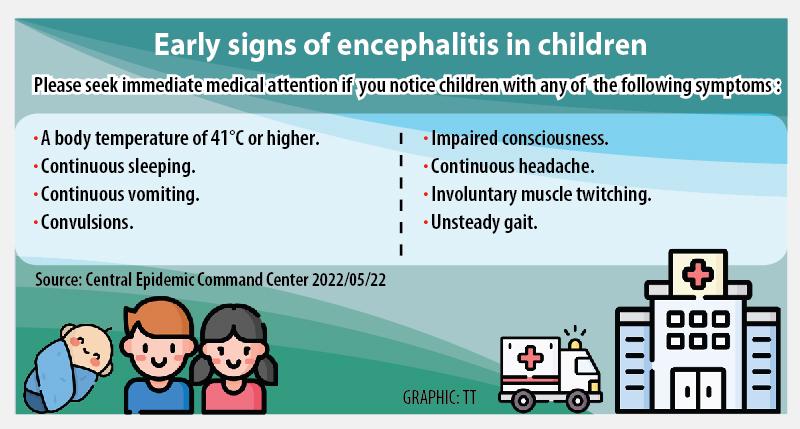Several children in Taiwan have developed acute encephalitis after contracting COVID-19, which could be caused by an excessive immune response, an immature blood-brain barrier, genes or environmental factors, doctors said.
Of the 22 children aged one to 12 with severe COVID-19, 11 have developed acute encephalitis, or inflammation of the brain, the Central Epidemic Command Center (CECC) said yesterday.
Ten children aged one to 12 have died of COVID-19 since April 19, five of whom had developed acute encephalitis, the center said.

Pediatric Infectious Diseases Society of Taiwan president Chiu Nan-chang (邱南昌) said the main factor that contributes to acute encephalitis in such cases is the sudden release of cytokines in large amounts, which damage the nervous system and is known as a “cytokine storm.”
Cytokines, a type of protein, are part of the body’s immune system and respond to pathogens.
However, if the pathogen triggers an excessive immune response, it can lead to a cytokine storm that can damage the body, including the nervous system, said Chiu, who is also a pediatric infection physician at Mackay Memorial Hospital.
In addition to a cytokine storm, other paths by which SARS-CoV-2 can enter the central nervous system and cause acute encephalitis were also observed in those cases, Chiu told the CECC’s news briefing on Saturday.
This can make it difficult to take measures to prevent complications that could cause a sudden onset of severe symptoms, he said.
Lee Chien-chang (李建璋), a physician at the National Taiwan University Hospital’s (NTUH) Department of Emergency Medicine, said the coronavirus could penetrate the system in the brain that shields against substances, including pathogens, in the blood, known as the blood-brain barrier.
In children infected with COVID-19, the virus could directly cross the barrier, because the structure is still immature, Chinese-language news site The Reporter quoted him as saying on Friday.
However, the reason the cases developed acute encephalitis would remain unknown without a pathological anatomy of the infection, he added.
SARS-CoV-2 can move from the nerves to the brain stem, resulting in acute encephalitis, NTUH pediatric infectious disease physician Lee Ping-ing (李秉穎) said in a radio interview on Thursday.
The current situation is similar to the enterovirus 71 epidemic in Taiwan in 1998, during which brain stem inflammation caused by the virus proved fatal for many children, Lee said.
As brain stem inflammation progressed quickly and caused excessive fluid buildup in the lungs or acute heart failure, the children died one to two days after infection, he said.
In the 1998 outbreak, about 120,000 children were confirmed to have enterovirus 71, of whom 405 were severe cases and 78 died, translating into a fatality rate of about 6 per 10,000 cases, the CECC said.
As of Thursday, the COVID-19 mortality rate for children up to nine was about 0.3 per 10,000 cases, it said.
It advised parents to have their children vaccinated against COVID-19 as soon as possible.
A similar trend also exists in Hong Kong, the center said.
The condition might be more prevalent among ethnic Chinese, although it could also be related to metabolic or environmental factors, said Centers for Disease Control Deputy Director-General Philip Lo (羅一鈞), deputy head of the CECC’s medical response division, on Wednesday.
Lee Chien-chang echoed the view, saying the different theories for the pathogenesis of brain inflammation linked to COVID-19 infection fail to explain the trend, because it was not seen in Western countries.

A relatively large earthquake may strike within the next two weeks, following a magnitude 5.2 temblor that shook Taitung County this morning, the Central Weather Administration (CWA) said. An earthquake struck at 8:18am today 10.2km west of Taitung County Hall in Taitung City at a relatively shallow depth of 6.5km, CWA data showed. The largest intensity of 4 was felt in Taitung and Pingtung counties, which received an alert notice, while areas north of Taichung did not feel any shaking, the CWA said. The earthquake was the result of the collision between the Philippine Plate and the Eurasian Plate, the agency said, adding

Snow fell in the mountainous areas of northern, central and eastern Taiwan in the early hours of yesterday, as cold air currents moved south. In the northern municipality of Taoyuan, snow started falling at about 6am in Fusing District (復興), district head Su Tso-hsi (蘇佐璽) said. By 10am, Lalashan National Forest Recreation Area, as well as Hualing (華陵), Sanguang (三光) and Gaoyi (高義) boroughs had seen snowfall, Su said. In central Taiwan, Shei-Pa National Park in Miaoli County and Hehuanshan National Forest Recreation Area in Nantou County saw snowfall of 5cm and 6cm respectively, by 10am, staff at the parks said. It began snowing

HOLIDAY EXERCISE: National forest recreation areas from north to south offer travelers a wide choice of sights to connect with nature and enjoy its benefits Hiking is a good way to improve one’s health, the Forestry and Nature Conservation Agency said, as it released a list of national forest recreation areas that travelers can visit during the Lunar New Year holiday. Taking a green shower of phytoncides in the woods could boost one’s immunity system and metabolism, agency Director-General Lin Hwa-ching (林華慶) cited a Japanese study as saying. For people visiting northern Taiwan, Lin recommended the Dongyanshan National Forest Recreation Area in Taoyuan’s Fusing District (復興). Once an important plantation in the north, Dongyanshan (東眼山) has a number of historic monuments, he said. The area is broadly covered by

Global bodies should stop excluding Taiwan for political reasons, President William Lai (賴清德) told Pope Francis in a letter, adding that he agrees war has no winners. The Vatican is one of only 12 countries to retain formal diplomatic ties with Taiwan, and Taipei has watched with concern efforts by Beijing and the Holy See to improve ties. In October, the Vatican and China extended an accord on the appointment of Catholic bishops in China for four years, pointing to a new level of trust between the two parties. Lai, writing to the pope in response to the pontiff’s message on Jan. 1’s